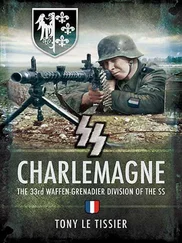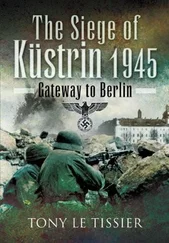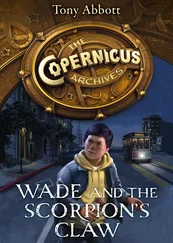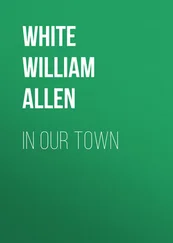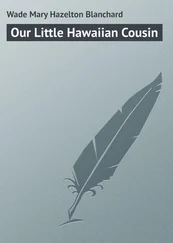I was taken in the tank to an emergency field hospital in a cinema. When I came to again, I was lying on the floor of the cinema with a frightful itch and a terrible thirst. The nurses had removed my weapons, as no one was allowed to keep them in hospital. Several hours later, after I had been through some hallucinations and stumbling around, Second Lieutenant Lorenz came to see me. He wanted to say good-bye to me and said: ‘I would have liked to have kept you with us.’ Then he shook his head and said: ‘Tonight we are going to break out to the west to the Americans.’
‘And what will happen to us remaining here?’
‘Berlin will be surrendering in the morning.’
No, the Russians were not going to get me. ‘Sir, I am coming with you, even if I have to tie myself to the tank. I am not stopping here!’
He grinned and said: ‘Alright, then!’
Those comrades that were coming with us supported me as I hobbled to the tank. The rear of the tank sloped a bit and I could hold on. The engine was beneath me and it was quite hot. Suddenly the woollen blanket I was wrapped in because of my fever caught fire.
During that night of 1/2 May, all available vehicles were deployed for an attack to the west to force a way out of the encirclement. In fact the troops fought with contempt for death, for they knew that the only possibility of getting away from the clutches of the Russians was by driving them back about ten kilometres. But only a narrow corridor was fought free, less than 100 metres wide, with the Russians on either side of it. The latter quickly brought together all their guns and mortars to bear and waited for us to come. Naturally, they were expecting us to try and break out.
The stream of vehicles rolled incessantly along this corridor to the west. Our tank was one of the last, as we had to secure the rear. Thousands of vehicles forced their way along this one free route. Ever more vehicles forced their way along, were shot up and caused traffic jams. We came through Spandau, which was already occupied by the Russians. A vast number of the inhabitants decided to come along with us to the Americans, telling us what chaos the Russians had caused. More and more vehicles fell out, and panicky confusion reigned on the streets. Thousands of dead lay around amid the burning vehicles and constant shelling. The wounded cried out for help, but no one heeded them.
In Spandau the stream of vehicles had to cross a bridge over the river. [21]The Russians were sitting only a few metres away and brought down everything possible to inflict more casualties. The bridge was already half destroyed by artillery fire and only one vehicle at a time could cross, but thousands wanted to. Every man opened fire on the Russians. Hundreds of dead and wounded lay in several layers on top of each other. At first there were twenty men clinging to our tank; all but four were shot off.
The route went on via Staaken. While there had been ten thousand wanting to break out through Spandau, there were now hardly a thousand at Staaken, and only a few hundred left when we came to Döberitz. We crossed the Döberitz Training Area with a Russian biplane keeping an eye on us and warning of our coming.
Our force was getting smaller and smaller. We saw no more infantry, only three Mark IVs and three Hetzers and several armoured personnel carriers were still together. Suddenly our tank stopped and refused to go any more. I was able to get aboard a Mark IV as our tank was blown up. The crew stayed behind. We then drove through a Russian artillery position before the Russians realised it and were away.
When we came to about 20 kilometres from Brandenburg, we went through a village that was swarming with Russians. This village lay deep in the Russian rear, the front being far distant. In any case the Russians had never expected us to appear here, but before they could recover from the shock and get hold of their weapons, we were away again. Then we had to drive round a corner and, as we drove round slowly, a fat Russian came out of a house on the corner and pulled up his sub-machine gun and started shooting at us. I already had my pistol out and fired back. As we turned the corner there was a sudden bang and I flew in a high curve off the tank. It had received a direct hit from an anti-tank gun and burst into flames. I thought to myself: ‘If you don’t want to be caught here, you are going to have to play it cool.’
But where should I go? There was thick smoke all around me, and a few metres away was a ditch with a bridge leading over it, so I hid myself in the reeds of the ditch until it was dark. Then I went further along through the reeds. The ditch opened out into a reed-lined lake. With two other soldiers that I found in the reeds, I stayed here four days. We hid ourselves in a willow bush. The ground was so wet that puddles formed whenever you put your foot down. None of us had anything to eat. I developed a high fever and was unable to think clearly about continuing our flight. It was very cold at night and my clothing was wet, so with the fever, no food, and Russians all around, there seemed no point in hanging on.
After four nights I was so weak that I could not last out any longer. Nearby was a farmhouse a little apart from the rest, at which I asked for something to eat. I was given some bread, a few potatoes boiled in their jackets, and a pan full of milk. The farmer’s wife also gave me a civilian suit, quite an old thing, but I put it on. I sank my uniform in the lake together with my pistol, medal, papers and letters. Then I slept in the hay for a few hours.
Next morning, 7 May, I set off with one of my comrades. Although every step was painful and I was still very weak, we left the farmhouse in good heart and marched off to the west. As far as we were concerned, the war was over and we hoped to get back home soon.
Unfortunately it did not work out this way and one and a half years in Russian captivity were to follow.
Tillery was captured on 6 May and released again after a week because of his wounds. He stayed with a farmer near Rathenow for about four weeks only to be arrested once more and sent to a camp near Brest-Litovsk, where a third of the 800 prisoners died, and he himself lost over 40 lbs in weight. He was repatriated in the autumn of 1946 as unfit for work, and obtained a job as an interpreter in an American hospital kitchen, where he soon regained his strength. He then made his career in the German Post Office. He married in 1954 and now has a son and a grandson serving in the Bundeswehr.
FOUR
The Siege of Klessin
I have pieced together this account from an after action report and extracts of a radio log provided by Lieutenant General Hans-Joachim von Hopffgarten, who was Ia (chief-of-staff) of the Panzergrenadier Division ‘Kurmark’ at the time. Further information was provided by Herr Helmut Jurisch, then a radio operator in the Tank Regiment ‘Brandenburg’. Prewar photographs and the diary of Herr Otto Karl Paul von Albedyll, the then 57-year-old squire of Klessin, were kindly provided by Dr. Reinhard Schmook of the Oderlandmuseum, Bad Freienwalde, plus additional photographs and material supplied by Dr Jürgen Freymuth OBE.
To find Klessin on the map, one has to follow the road running north out of Frankfurt on the Oder to Lebus and then look for the first turn-off on the right, where this tiny hamlet sits on the eastern edge of the Reitwein Spur, a good hundred feet above the Oder valley. The Klessin of today bears little resemblance to the Klessin of early 1945, the few remaining houses having been resited, but the geographical features are the same, with two tracks rising steeply from the Oder valley on either side of the promontory on which the Schloss, or manor house, once stood. Capping the promontory between these tracks, the house had magnificent commanding views over the valley that gave it its military significance, but today its site and former gardens are completely overgrown with trees.
Читать дальше


